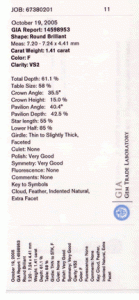mdx
Brilliant_Rock
- Joined
- Mar 1, 2002
- Messages
- 570
We just received a batch of GIA stones and note that the vendor copy now includes
Total Depth
Table Size
Crown Angle
Crown Height
Pavilion angle
Pavilion Depth
Star Length
Lower Half
Then the rest of the usual stuff
The dates of the certs will the additional data are from 20th Oct 2005
A pleasant surprise, we where only expecting this in Jan2006 when the new certs are launched
Johan
Total Depth
Table Size
Crown Angle
Crown Height
Pavilion angle
Pavilion Depth
Star Length
Lower Half
Then the rest of the usual stuff
The dates of the certs will the additional data are from 20th Oct 2005
The data is not included on the customer copy
A pleasant surprise, we where only expecting this in Jan2006 when the new certs are launched
Johan














300x240.png)